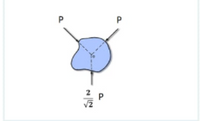Question
Solve for the resultant force (magnitude) and (direction) of the concurrent forces shown. The two downward forces are inclined at 1:1.

Expert Solution
This question has been solved!
Explore an expertly crafted, step-by-step solution for a thorough understanding of key concepts.
Step by stepSolved in 2 steps with 1 images

Knowledge Booster
Similar questions
- A 150 Newton force is pulling 70 degrees above the horizontal and somewhat to the right. Tell me first the vertical and second the horizontal magnitudes in Newtons of the two smaller vectors that could be added to get this larger vector.arrow_forwardDetermine the resultant force magnitude, direction, and its angle from the x-axis for force components F1 & F2, components F2 & F3, and components F3 & F4. NOTE: must be solved using the parallelogram method, not the rectangulararrow_forwardTwo forces acting at a point make angles 25° and 45° respectively with their resultant force which has a magnitude of 15N . Find the magnitude of the two components.arrow_forward
- A crate sits on a wooden horizontal surface (a wooden floor). The figure shows a top view of this looking down onto the crate (gravity would be acting into the page). Man one and man two apply forces F1 and F2, at angles of θ1 and θ2 respectively, with the goal of moving the crate in the x-direction. A resultant force of Fr = 30.5 lbs in the x-direction is required to accomplish this. All of the forces are in the xy plane. If man one applies a force of F1 = 21 lbs at an angle of θ1 = 16° from the positive x-axis, complete the following steps to determine the magnitude and angle of the force man two must apply. c) Combine these two equations to develop an expression for tan(θ2) in terms of Fr, F1, F2, and θ1. Remember that the crate does not move along the y-direction. d)Solve numerically for the value of θ2 in degrees. e)Using this value for θ2 and other known values, solve numerically for the value of F2 in lbs.arrow_forwardUsing the method of components, find the resultant of the following concurrent forces. Note: After solving for the Angle of the Resultant, you must then determine the Direction of the Resultant relative to Horizontal (positive x-axis) in a CCW (counter-clockwise direction). Sometimes the Direction of the Resultant may be the same as the Angle of the Resultant. However, you must always calculate both: the Angle of the Resultant (based on the Resultant triangle sketch) and then the Direction of the Resultant based on Horizontal (positive x-axis) in a CCW direction from horizontal.arrow_forwardThe angle between two forces of 34 N (Newtons) and 46 N is 47°. Find the magnitude of the resultant force.arrow_forward
arrow_back_ios
arrow_forward_ios